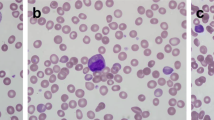Abstract
A 5-month-old infant with bone findings on x-ray presented an apparent contradiction including findings of both diffusely dense bones and rickets in the context of a history and laboratory investigation that suggested leukemia. Next generation gene panel sequencing revealed a TCIRG1 mutation which is consistent with autosomal recessive osteopetrosis. The paradoxical x-ray findings underscore a recently elucidated mechanism for the pathogenesis of a TCIRG mutation. This case highlights the importance of recognizing this radiographic, seeming contradictory, association in the context of a confusing clinical presentation. Failure to recognize this pattern promptly may lead to a delay in diagnosis, thus potentially permanent organ failure.




Similar content being viewed by others
References
Tolar J, Teitelbaum SL, Orchard PJ. Osteopetrosis. N Engl J Med. 2004;351(27):2839–49.
Gonen KA, Yazici Z, Gokalp G, Ucar AK. Infantile osteopetrosis with superimposed rickets. Pediatr Radiol. 2013;43(2):189–95.
Kaplan FS, August CS, Fallon MD, Gannon F, Haddad JG. Osteopetrorickets. The paradox of plenty. Pathophysiology and treatment. Clin Orthop Relat Res. 1993;294:64–78.
Essabar L, Meskini T, Ettair S, Erreimi N, Mouane N. Malignant infantile osteopetrosis: case report with review of literature. Pan Afr Med J. 2014;17:63.
Freese J, Greenup E, Sunil B, Ashraf AP. Osteopetrorickets presenting with failure to thrive and hypophosphatemia. J Endocr Soc. 2020;4(6):bvaa044.
Stattin EL, Henning P, Klar J, McDermott E, Stecksen-Blicks C, Sandstrom PE, et al. SNX10 gene mutation leading to osteopetrosis with dysfunctional osteoclasts. Sci Rep. 2017;7(1):3012.
Calder AD, Arulkumaran S, D’Arco F. Imaging in osteopetrosis. Bone. 2022;165:116560.
Frattini A, Orchard PJ, Sobacchi C, Giliani S, Abinun M, Mattsson JP, et al. Defects in TCIRG1 subunit of the vacuolar proton pump are responsible for a subset of human autosomal recessive osteopetrosis. Nat Genet. 2000;25(3):343–6.
Capo V, Abinun M, Villa A. Osteoclast rich osteopetrosis due to defects in the TCIRG1 gene. Bone. 2022;165:116519.
Schinke T, Schilling AF, Baranowsky A, Seitz S, Marshall RP, Linn T, et al. Impaired gastric acidification negatively affects calcium homeostasis and bone mass. Nat Med. 2009;15(6):674–81.
Donnelly LF, Johnson JF 3rd, Benzing G. Infantile osteopetrosis complicated by rickets. AJR Am J Roentgenol. 1995;164(4):968–70.
Even-Or E, Stepensky P. How we approach malignant infantile osteopetrosis. Pediatr Blood Cancer. 2021;68(3):e28841.
Katsafiloudi M, Gombakis N, Hatzipantelis E, Tragiannidis A. Osteopetrorickets in an infant with coexistent congenital cytomegalovirus infection. Balkan J Med Genet. 2020;23(2):107–10.
Wu CC, Econs MJ, DiMeglio LA, Insogna KL, Levine MA, Orchard PJ, et al. Diagnosis and management of osteopetrosis: consensus guidelines from the osteopetrosis working group. J Clin Endocrinol Metab. 2017;102(9):3111–23.
Dent CE, Smellie JM, Watson L. Studies in Osteopetrosis. Arch Dis Child. 1965;40(209):7–15.
Author information
Authors and Affiliations
Corresponding author
Ethics declarations
Consent for publication
Consent for publication of this case report was obtained from the patient’s mother.
Competing interests
The authors declare no competing interests.
Additional information
Publisher's Note
Springer Nature remains neutral with regard to jurisdictional claims in published maps and institutional affiliations.
Rights and permissions
Springer Nature or its licensor (e.g. a society or other partner) holds exclusive rights to this article under a publishing agreement with the author(s) or other rightsholder(s); author self-archiving of the accepted manuscript version of this article is solely governed by the terms of such publishing agreement and applicable law.
About this article
Cite this article
Behr, G., Kuhn, M., Oved, J.H. et al. Osteopetrorickets: two contradictory patterns—one unifying diagnosis. Skeletal Radiol 53, 817–820 (2024). https://doi.org/10.1007/s00256-023-04443-z
Received:
Revised:
Accepted:
Published:
Issue Date:
DOI: https://doi.org/10.1007/s00256-023-04443-z




